Agile OKRs combine the Objective & Key Results goal-setting framework from John Doerr and the Agile way of managing projects. Together, they form a powerful combo to align projects with company goals.
What Are OKRs?
Simply put, objectives and key results (OKR) is a framework for goal-setting used to define and track goals more efficiently. Used for mapping high-end company goals, the main benefits of OKRs are:
- Bringing focus by setting up straightforward, strong, and inspirational goals
- Alignment on every work level by embracing transparency and simplicity of the work priorities
- Boosting engagement by sharing strategic goals and empowering people to determine actionable steps toward vision’s completion
Brief History and Main OKR Attributes
Introduced in the 80s by Andrew Grove, known as the "Father of OKR", the approach of setting measurable goals had really taken off at the brinck of the new century when Google adopted OKRs. Praised for its efficiency in pursuing bold missions by keeping everyone's focus and awareness on the same page - on the most important topics - the OKRs framework is now applied by tech giants such as LinkedIn, Twitter, and Microsoft, among many others.
The key to the successful implementation of the OKR framework is having the proper means to measure, track and evaluate the results of the set goals.
Grasping the meaning of OKR implies understanding its main components first - "objectives" and "key results."
An Objective is a short and engaging description of your goal. It should motivate your team toward achieving it. Objectives represent an agreement on what the company’s top priority goals are. As per venture capitalist and a leading figure of the OKR movement John Doerr, Objectives should be:
- Significant
- Concrete
- Action-oriented
- Inspirational
On the other hand, Key Results represent a set of measurements for the outcomes you achieve. Their purpose is to show the progress toward the set Objective, so it's imperative to use quantitative metrics when describing them.
In other words, Key Results should be:
- Specific and time-bound
- Realistic
- Measurable and verifiable
How Agile and OKRs Work Together?
Numbers indicate 60% - 90% failure rates when it comes to strategy execution. The gap between a company vision and its achievement calls for a complementary approach to align teams and individuals towards the same goal.
An Agile approach to project management represents the mechanism and methods a team employs to work together. Meanwhile, OKRs represent our business goals and set the direction of our business. Combining the philosophies of OKR and Agile project management can help align work with the company's mission, encourage employee engagement, and boost productivity.
Let’s learn more about how OKR and Agile coexist and complement one another.
Alignment with Strategic Goals
Adopting the Agile approach to work management is an excellent foundation to introduce meaningful processes, practices, and principles into our work. Introducing iteration, collaboration, proactiveness, and changes on a departmental and individual level means we have succeeded in embracing the Agile mindset. Although Agile successfully aligns our work processes, our goals also need to be shared and embraced by everyone.
We need a way to bring our goals to the attention of individual team members to achieve complete alignment at every organizational level. The OKR framework provides a simple yet very effective way to do that - transparency across the company. Having shared top goals ensures that people are aware of their work’s business value, collaborate better, and feel more responsible and accountable for their work.
 Cascading work management
Cascading work management
Goal Evaluation through OKR Cadences
A great advantage and a vital part of the OKR framework is the regularity of their assessment through frequent cadences or Agile ceremonies. While organizations can tweak these as per their own needs, a common practice is to evaluate high-end goals yearly and team OKRs quarterly. This approach enables organizations and teams to respond more adequately to changes along the way and introduce improvements in the next iteration.
While one of the core principles of Agile project management calls for delivering a working software more frequently, embracing changes, and adjusting towards effectiveness, OKRs do the same for objectives. OKRs can indeed thrive in an Agile environment allowing goals to be set more quickly, evaluated promptly, and open to improvement.
Tracking Outcomes with OKRs
Furthermore, setting up OKRs is a compass allowing us to track if we are moving in the right direction. They keep us aware of the state of our progress and measure our business results.
OKRs help Agile teams track progress and make necessary changes along the way and narrow down the focus and team efforts toward a specific objective. Eliminating the potential widening of our goals’ scope is essential in following our set company path.
 Creating OKRs on a Kanban card
Creating OKRs on a Kanban card
Why OKRs Can Support an Agile Transformation?
Lack of alignment between business and teams is one of the leading reasons behind every Agile transformation, as the latest State of Agile Report indicates. The OKR framework aims to resolve that problem through its intrinsic enhanced visibility and transparency.
Adopting the Agile way to project management and scaling agile across the company also tackles similar challenges: aligning with the company’s goals, creating agile teams that adapt to changes and shifting priorities, and achieving synchronization between strategy and execution.
Let’s look at how setting and tracking objectives and key results can help you undergo a successful Agile transformation.
Clear and Adaptive Goals
Agile thinking calls for simplicity and achieving a sustainable working pace. When applied on a strategic level, this approach to performing work promotes action-oriented and concrete company goals.
On the one hand, organizational agility stems from bringing full transparency to the strategic goals so they can become clearer and easily accessible to all stakeholders. On the other hand, the constant collaboration between customers and internal teams when defining your business vision enables you to respond to changes in an untroubled and stress-free way.
Greater Focus and Work Prioritization
Agile requires that you avoid upfront planning to allocate more time for value-adding activities. Applying Objectives and Key Results on a strategic level and regularly reviewing them helps in their timely synchronization with emerging market trends or shifting business priorities.
Combining the two approaches when setting your high-level goals creates a clear understanding of the current priority and allows for a greater focus on producing actual customer value.
Continuous Feedback and Improvement
At the heart of Agile lies the principle of welcoming changes during the project’s progress. Being receptive to change gives you the leverage to adapt and satisfy the latest demands.
Since market conditions and client requirements can always alter, creating an environment where an abrupt shift of priorities will not bring chaos into the workflow is crucial. As vital as synchronous communication is for Agile teams, synchronizing your strategic objectives and their execution needs to remain pulsating at all times.
Establishing regular feedback loops to reflect on and evaluate your strategic OKRs will create another layer of agility at your organization's management level. This also helps to identify improvement opportunities easily.
How to Achieve Agility with Agile and OKRs through Kanban?
The Agile mindset creates a perfect environment for setting focused and reliable OKRs.
Agile practices such as visualizing work bring transparency to the company on the one hand. On the other hand, introducing feedback loops and focusing on customer needs helps teams shift their attention from maximizing output to producing customer value and adapting to changing requirements. That way, Agile, and OKRs’ coexistence fosters the alignment between strategy and execution.
To achieve that, a method such as Kanban offers the right means to highlight that alignment. It aims to bring transparency, efficiency, and continuous improvement under the same roof.
Let's take a closer look at how that happens in practice and how Kanban can complement an OKRs implementation.
Enhanced High-Level Visibility
Through the use of Kanban principles and practices, the method brings the focus to achieving visibility and workflow improvement. That being said, it offers a straightforward way to visualize work not only on a team level but across the company’s management too. The Kanban method aims to visualize interdependent value streams in organizations, so you can better understand and optimize them.
In practice, this can happen with the help of a network of related Kanban boards. Talking from an OKR perspective, you can think of the top of this network as a management hub where both company and team-level objectives and key results are visualized. Going further down, the teams get to manage their own OKRs - connecting them with actionable projects or tasks on their team Kanban boards.
 Connecting strategic and team-level OKRs on a Kanban board
Connecting strategic and team-level OKRs on a Kanban board
This is how objectives are mapped and connected to key results and their execution. It enables high-level transparency, allowing all stakeholders to stay on top of the company strategy and its execution.
Setting OKRs in an Agile environment will help you reach a company-wide alignment with your vision. It will also boost people’s engagement by allowing them to track their work progress and contribution to the team or strategic objectives.
Limiting Work in Progress
Crucial to the objectives and key results method is bringing focus to work. The OKR framework calls for thinking of what’s most important and what is the priority now, which forces us to set a limited number of goals at a time - the ones that matter the most. The Kanban practice of setting limits to your work in progress further prevents you from overburdening with too many objectives, losing focus, and interrupting your work rhythm.
 Visualization of objectives’ WIP limit reached on a Kanban board
Visualization of objectives’ WIP limit reached on a Kanban board
Establishing Regular Feedback Loops
Objectives are action-oriented, they require people’s creativity, and therefore they imply regular feedback exchange. Executing strategic and team OKRs is highly dependent on people’s input. The Kanban cadences help you establish regular feedback loops and provide a solution to both management and teams.
The Service Delivery reviews, for example, allow teams to incorporate lessons learned into their workflows regularly and decide on further actions to satisfy their key results. The operations review, on the other hand, is designed for team synchronization and making decisions on improvements.
 Kanban cadences
Kanban cadences
The output from team-level meetings serves as a basis for company-level gatherings such as strategic OKR reviews. Keeping this close alignment between team and management brings agility and makes a company capable of responding promptly to necessary changes.
What Are the Benefits of OKRs in an Agile Environment?
Why do OKRs thrive in an Agile environment? Introducing objectives and key results (OKR) impacts both business performance and spreads a new organizational culture.
Business alignment at all levels
Setting high-end goals send a clear message to every team member about the company’s aspirations and direction. That creates transparency and serves as a foundation for a constructive discussion about the business outcomes. The awareness of all teams about the company OKRs enables proactive thinking and engagement when it comes to execution and results.
Focused prioritization
Except for alignment with the organization’s strategic plans, OKRs on the individual team level allow for focusing on short-term actionable goals. This feasible OKR planning with a goal cycle of 1-2 months enables evaluating the performance, identifying milestones, and improving the next iteration cycle.
Increased performance
By encouraging autonomy and transparency throughout the company, OKRs create an environment of engagement and responsibility. Employee involvement not only impacts performance but also sets a tone for a long-lasting mindset transition.
How to Create OKRs?
The key to proper OKR setup is a deep understanding of what their purpose is. While a good set of OKR is strictly dependent on the business domain, among other industry-specific factors, writing effective OKRs can be done by answering a few simple questions.
→ Objectives’ purpose is to communicate a company’s priorities. They should represent a company’s vision. So your Objective should answer the question “What.” Additionally, make sure your objectives are meaningful, clear, and inspirational.
→ Key Results represent the means to evaluate and track the execution of your Objective. As such, your key results should answer the “How” questions. They need to be specific and realistic, and you should be able to measure them.
Agile OKR - Frequently Asked Questions (FAQ)
What Is an OKR in Agile?
OKR stands for Objectives and Key Results. It is a goal-setting framework that is commonly used in Agile methodologies to help teams align around common objectives and track progress towards achieving them. The framework consists of setting specific, measurable, and achievable objectives and identifying key results that will indicate progress towards those objectives. OKRs are often used in conjunction with agile practices such as sprint planning, retrospectives, and continuous improvement to help teams stay focused and aligned toward achieving their goals.
How to Apply OKRs in an Agile Organization?
To apply OKRs (Objectives and Key Results) in an Agile organization, the following steps can be followed:
-
Align OKRs with Agile principles: The OKRs should be aligned with the Agile manifesto and principles to ensure that they are in sync with the organization's values and goals.
-
Define clear and measurable objectives: The objectives should be specific, measurable, achievable, relevant, and time-bound (SMART) to ensure that they are clear and understandable to everyone in the organization.
-
Identify key results: The key results should be quantifiable and measurable and should reflect progress toward achieving the objectives.
-
Involve all stakeholders: All stakeholders, including team members, managers, and leaders, should be involved in the process of setting OKRs in an Agile environment.
-
Prioritize OKRs: The organization should prioritize the OKRs based on their importance and impact on the organization's goals.
Is OKR a Part of Agile?
OKR (Objectives and Key Results) is not a direct part of Agile methodology, but it can be used in conjunction with Agile practices to set and measure goals for teams and individuals. OKRs focus on setting specific, measurable, achievable, relevant, and time-bound objectives and then tracking progress toward those objectives using key results. This approach can help teams align their efforts with overall business objectives and track progress towards their goals in an Agile way.
How Do OKRs Contribute to Agile?
OKRs (Objectives and Key Results) contribute to Agile in several ways:
-
Alignment: OKRs help align teams and individuals towards a standard set of goals and objectives. This alignment is crucial for Agile teams that work collaboratively and iteratively.
-
Focus: OKRs provide a clear focus for Agile teams. They help teams prioritize their work and ensure everyone is working towards the most critical objectives.
-
Transparency: OKRs promote transparency in Agile teams. By making objectives and critical results visible to everyone, team members can see progress and identify any issues or roadblocks that must be addressed.
-
Continuous Improvement: OKRs encourage continuous improvement in Agile teams. By setting ambitious but achievable goals, teams continually look for ways to improve their work with each new iteration.
Businessmap is the most flexible software
to align work with company goals
In Summary
Understanding what OKR is and the framework’s smart implementation into an Agile environment is the shortcut to mapping, tracking, and measuring our business outcomes.
Applying the Agile mindset with the OKR framework enables achieving business agility through:
- Employee engagement by letting people self-organize
- Enhanced transparency by using visualization techniques
- Goal alignment by regular evaluation of the results





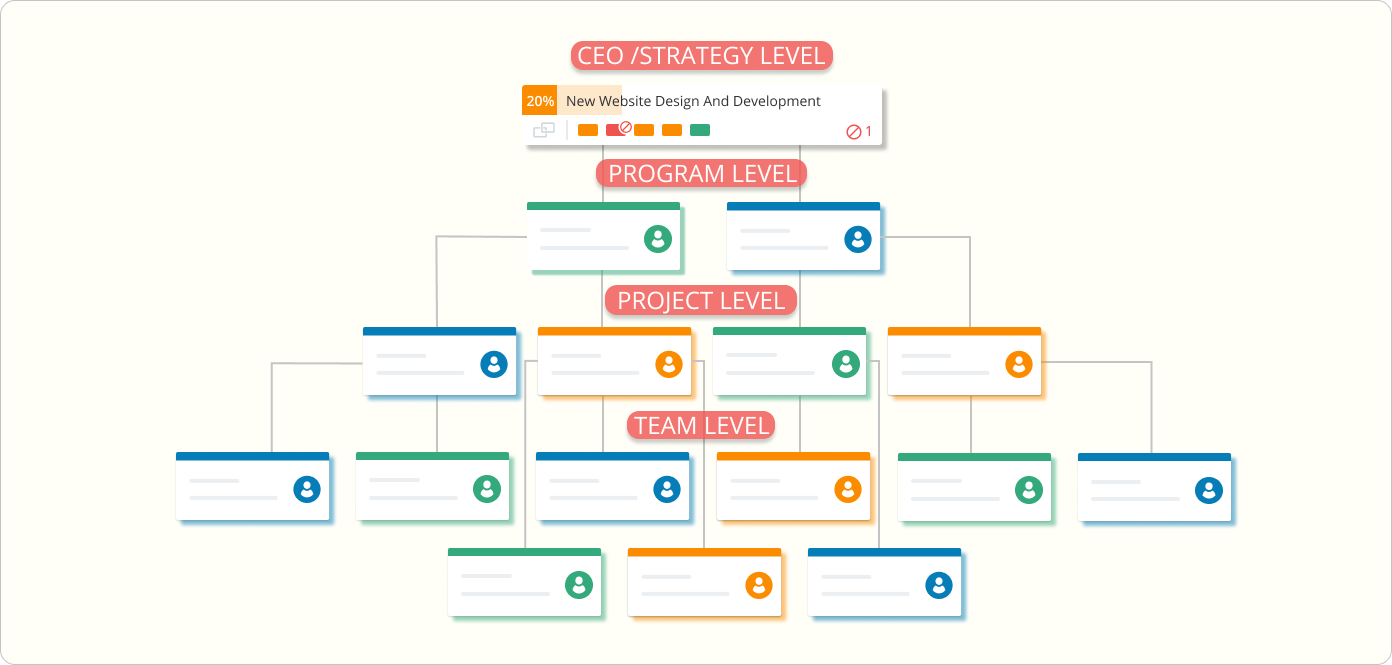 Cascading work management
Cascading work management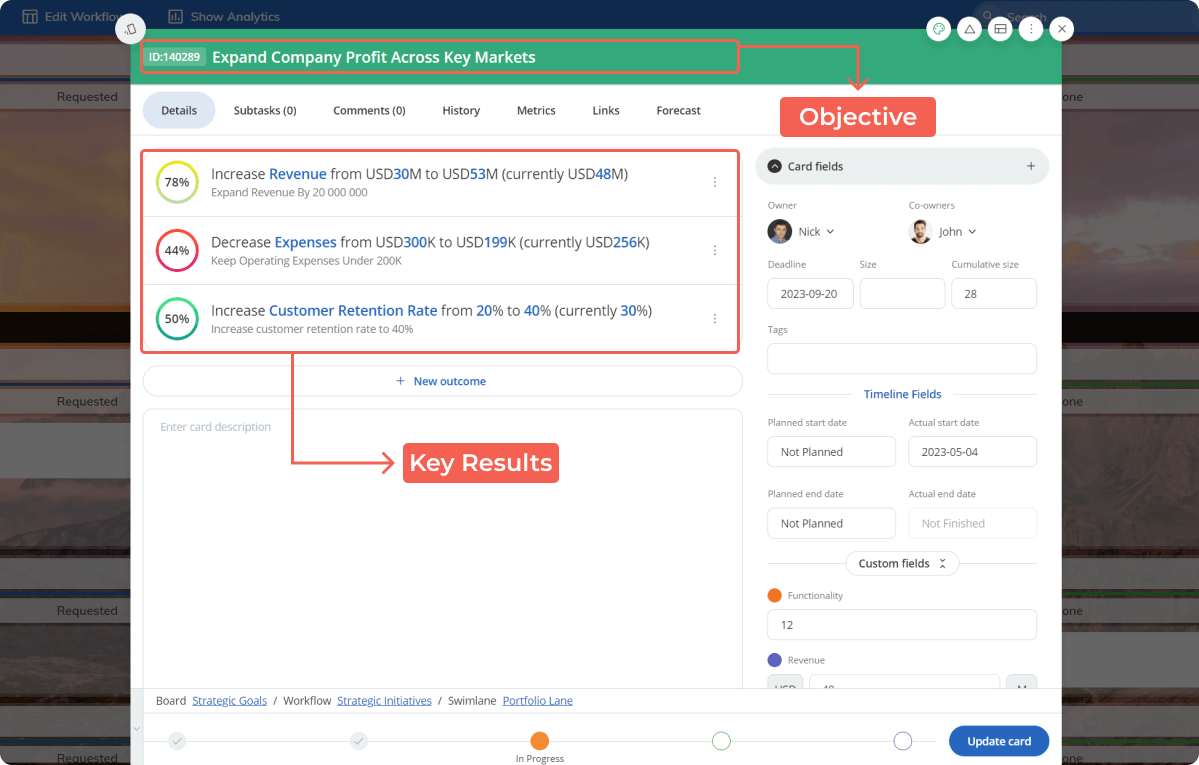 Creating OKRs on a Kanban card
Creating OKRs on a Kanban card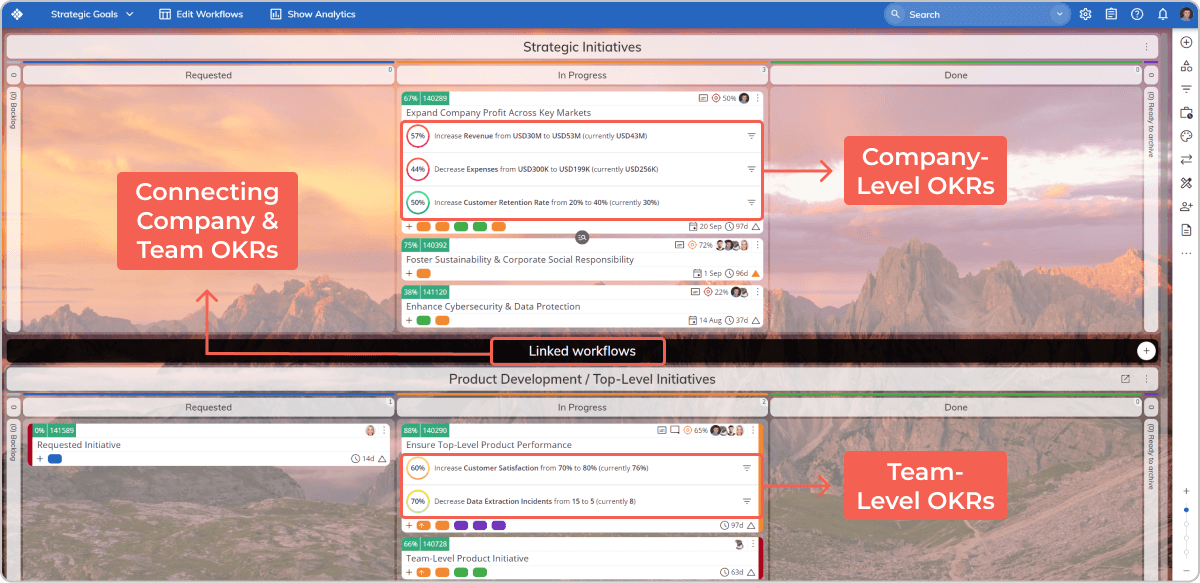 Connecting strategic and team-level OKRs on a Kanban board
Connecting strategic and team-level OKRs on a Kanban board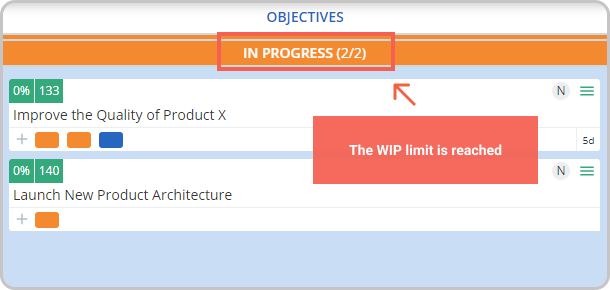 Visualization of objectives’ WIP limit reached on a Kanban board
Visualization of objectives’ WIP limit reached on a Kanban board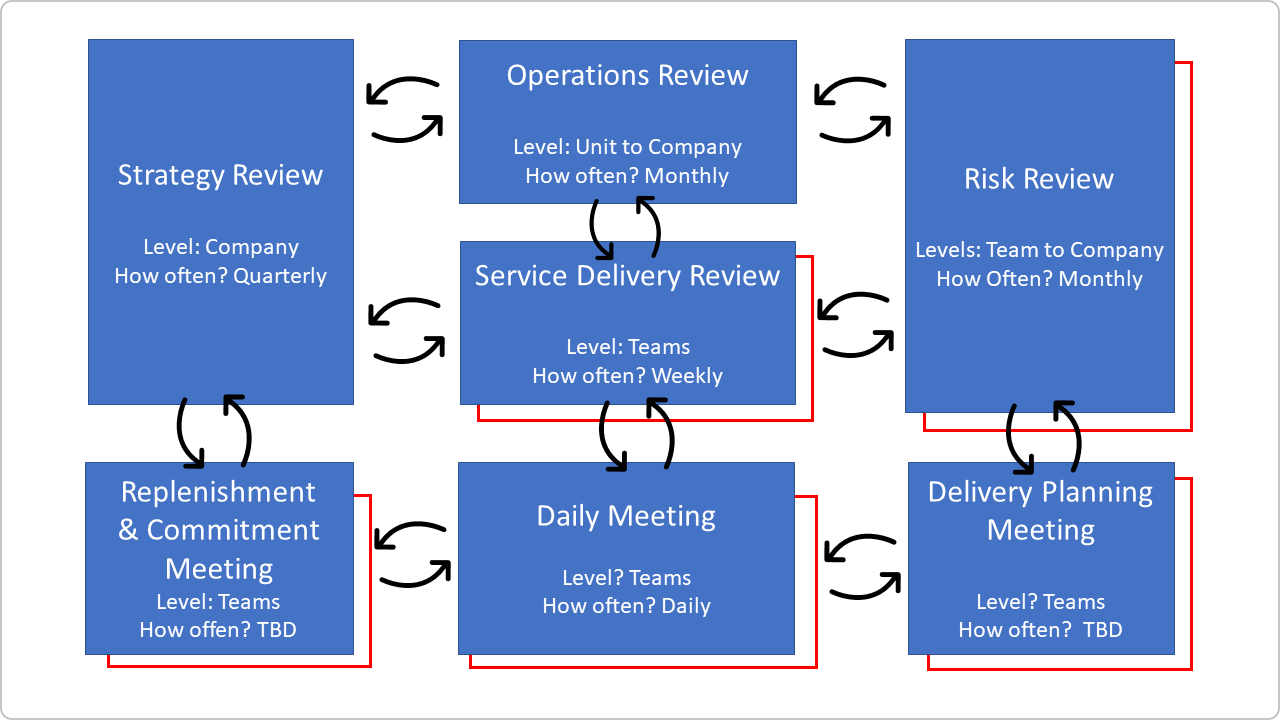 Kanban cadences
Kanban cadences

